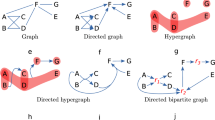Abstract
In this paper, we apply new geometric and combinatorial methods to the study of phylogenetic mixtures. The focus of the geometric approach is to describe the geometry of phylogenetic mixture distributions for the two state random cluster model, which is a generalization of the two state symmetric (CFN) model. In particular, we show that the set of mixture distributions forms a convex polytope and we calculate its dimension; corollaries include a simple criterion for when a mixture of branch lengths on the star tree can mimic the site pattern frequency vector of a resolved quartet tree. Furthermore, by computing volumes of polytopes we can clarify how “common” non-identifiable mixtures are under the CFN model. We also present a new combinatorial result which extends any identifiability result for a specific pair of trees of size six to arbitrary pairs of trees. Next we present a positive result showing identifiability of rates-across-sites models. Finally, we answer a question raised in a previous paper concerning “mixed branch repulsion” on trees larger than quartet trees under the CFN model.
Similar content being viewed by others
References
Allman, E.S., Rhodes, J.A., 2006. The identifiability of tree topology for phylogenetic models, including covarion and mixture models. J. Comput. Biol. 13(5), 1101–1113.
Bandelt, H.J., Dress, A.W.M., 1992. A canonical decomposition theory for metrics on a finite set. Adv. Math. 92, 47–105.
Felsenstein, J., 2004. Inferring Phylogenies. Sinauer Press, Sunderland.
Gawrilow, E., Joswig, M., 2005. Geometric reasoning with polymake. arXiv:math.CO/0507273.
Grünbaum, B., 2003. Convex Polytopes. Springer, Berlin.
Kaibel, V., Pfetsch, M.E., 2003. Some algorithmic problems in polytope theory. In: Algebra, Geometry, and Software Systems, pp. 23–47. Springer, Berlin.
Matsen, F.A., Steel, M., 2007. Phylogenetic mixtures on a single tree can mimic a tree of another topology. arXiv:0704.2260v1 [q-bio.PE].
Meacham, C.A., 1983. Theoretical and computational considerations of the compatibility of qualitative taxonomic characters. In: J. Felsenstein (Ed.), Numerical taxonomy, NATO ASI Series, vol. G1, pp. 304–314. Springer, Berlin.
Mossel, E., Steel, M., 2004. A phase transition for a random cluster model on phylogenetic trees. Math. Biosci. 187(4), 189–203.
Ochman, H., Lawrence, J.G., Groisman, E.A., 2000. Lateral gene transfer and the nature of bacterial innovation. Nature 405(6784), 299–304.
Rokas, A., Williams, B.L., King, N., Carroll, S.B., 2003. Genome-scale approaches to resolving incongruence in molecular phylogenies. Nature 425(6960), 798–804.
Semple, C., Steel, M., 2003. Phylogenetics. Oxford Lecture Series in Mathematics and its Applications, vol. 24. Oxford University Press, Oxford.
Simon, C., Nigro, L., Sullivan, J., Holsinger, K., Martin, A., Grapputo, A., Franke, A., McIntosh, C., 1996. Large differences in substitutional pattern and evolutionary rate of 12S ribosomal RNA genes. Mol. Biol. Evol. 13(7), 923–932.
Steel, M.A., Szekely, L.A., Hendy, M.D., 1994. Reconstructing trees when sequence sites evolve at variable rates. J. Comput. Biol. 1(2), 153–163.
Štefankovič, D., Vigoda, E., 2007. Phylogeny of mixture models: robustness of maximum likelihood and non-identifiable distributions. J. Comput. Biol. 14(2), 156–189.
Ziegler, G.M., 1994. Lectures on Convex Polytopes. Springer, Berlin.
Author information
Authors and Affiliations
Corresponding author
Additional information
F.A. Matsen’s and M. Steel’s research was supported by the Allan Wilson Centre for Molecular Ecology and Evolution.
E. Mossel’s research was supported by a Sloan fellowship in Mathematics, NSF awards DMS 0528488 and DMS 0548249 (CAREER) and by ONR grant N0014-07-1-05-06.
Rights and permissions
About this article
Cite this article
Matsen, F.A., Mossel, E. & Steel, M. Mixed-up Trees: the Structure of Phylogenetic Mixtures. Bull. Math. Biol. 70, 1115–1139 (2008). https://doi.org/10.1007/s11538-007-9293-y
Received:
Accepted:
Published:
Issue Date:
DOI: https://doi.org/10.1007/s11538-007-9293-y




